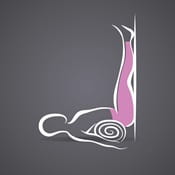Incontinence or other pelvic floor conditions affect more than 25 million people. However, a little education can go a long way when it comes to therapy and exercise as alternatives to surgery or medication. A weak pelvic floor can make for some embarrassing moments, but you don’t have to suffer in silence anymore. Breath and ohm your way into a strong, and relaxed, pelvic floor with a few yoga poses.
1. Legs Up the Wall
Sit on the floor with one side of your body grazing the wall. Lie back with your head and shoulders on the floor. If you have back pain, put a block under your buttocks to line up your spine. Swing your legs up against the wall and allow your hands to fall out to your sides, palms facing up. Close eyes and breathe deeply, relaxing into pose. Hold 1 minute. If you have any pelvic floor condition, chances are your muscles are constantly being squeezed and tightened to prevent leakage. With this position you can allow gravity to help you fully relax those muscles without the fear of leaking.

2. Reclined Bound Angle
Lie on a mat with knees bent and feet flat on the floor. Bring the soles of your feet together and allow your knees to open. Rest arms by your sides with palms up. Close your eyes and breathe deeply. Hold 1 minute. Your inner thighs help stabilize your pelvic floor. When they’re flexible, you’re able to activate your pelvic muscles more deeply.

3. Bridge
Start by lying on your back. Place your feet flat on the floor and point your knees toward up. Press your lower back into the mat and tilt your pelvis toward your navel on an inhale. Exhale and tilt your pelvis toward your feet, arching the lower back off the floor slightly. Inhale and return the pelvis to neutral. Exhale and press your hips up toward the sky, as high as you can. Bridge pose allows you to bring more strength and awareness to your pelvic floor area. This pose also helps stretch the hips and spine.
While a strong pelvic floor is important, it’s also important to allow those muscles to relax to prevent discomfort and your symptoms from getting worse.



